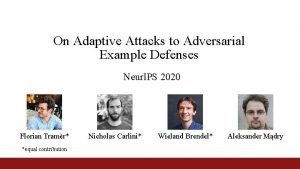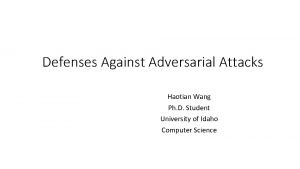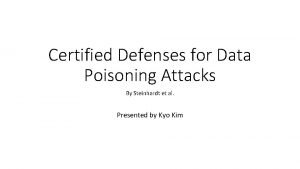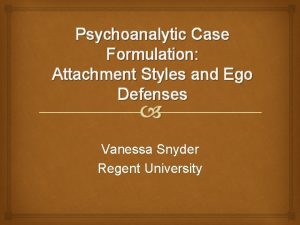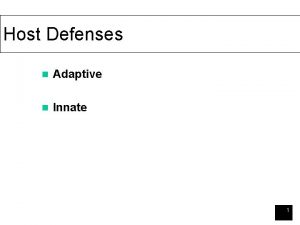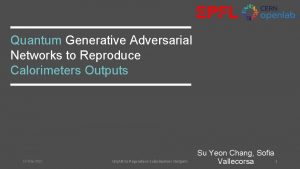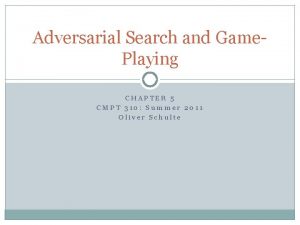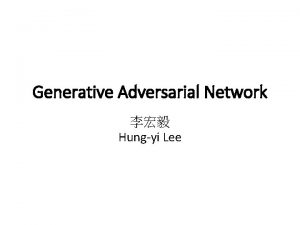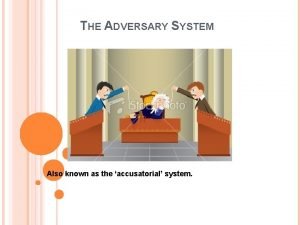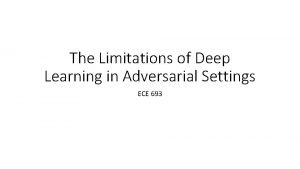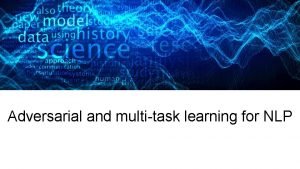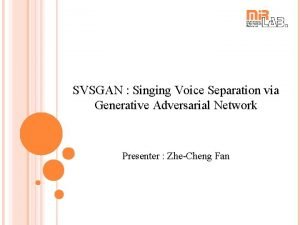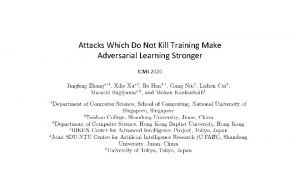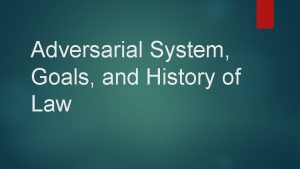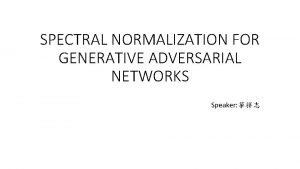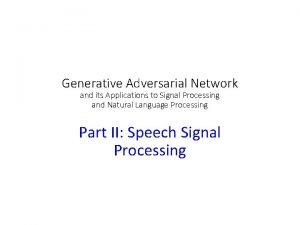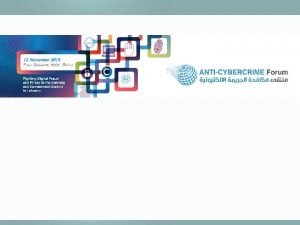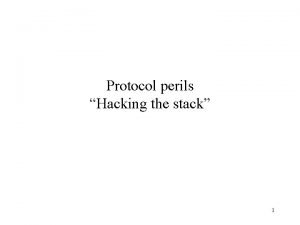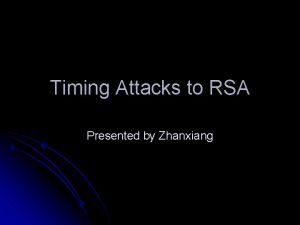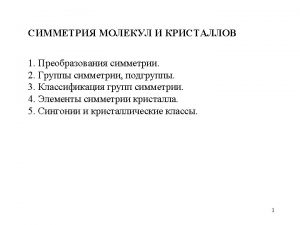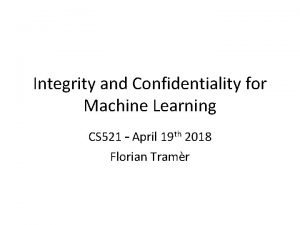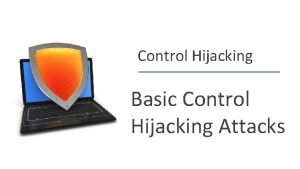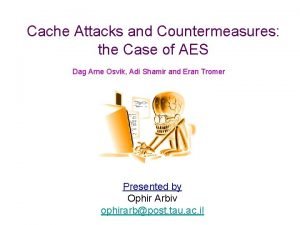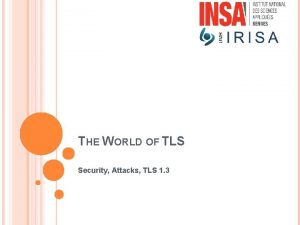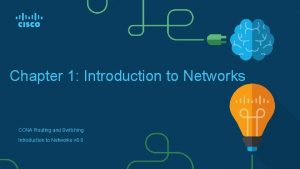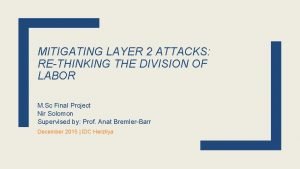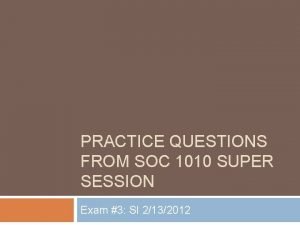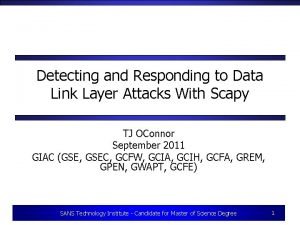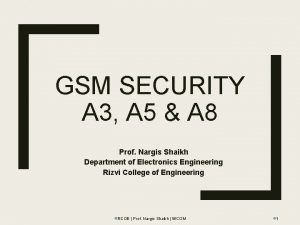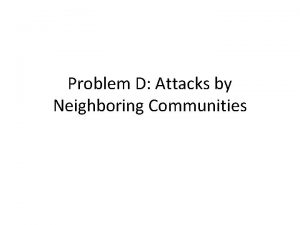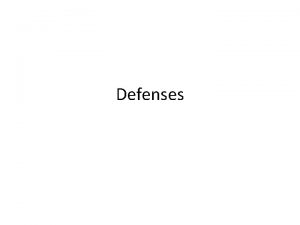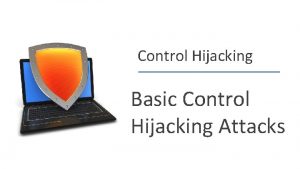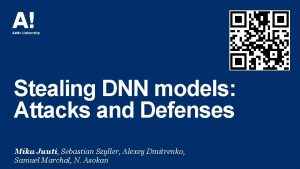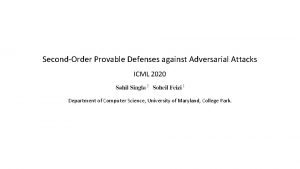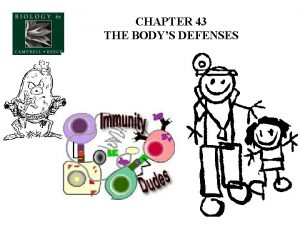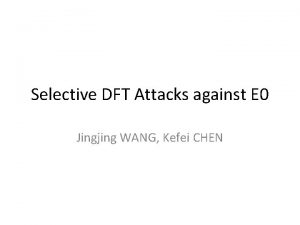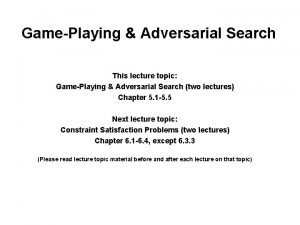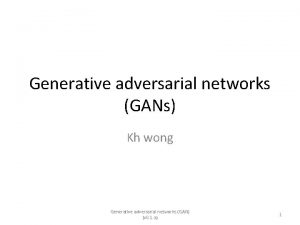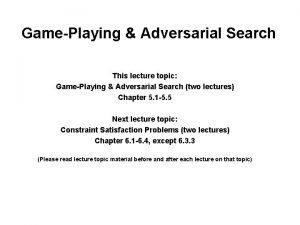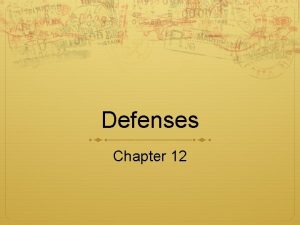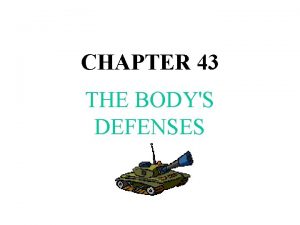Defenses Against Adversarial Attacks Haotian Wang Ph D











![DISTILLATION The concept of ‘Distillation’ was first introduced by Hinton [1] G. Hinton, O. DISTILLATION The concept of ‘Distillation’ was first introduced by Hinton [1] G. Hinton, O.](https://slidetodoc.com/presentation_image_h/04c6c9384cf40b2df878198b7de24516/image-12.jpg)






![Guo [1] studied a number of image processing tools, such as image cropping, compressing, Guo [1] studied a number of image processing tools, such as image cropping, compressing,](https://slidetodoc.com/presentation_image_h/04c6c9384cf40b2df878198b7de24516/image-19.jpg)

































- Slides: 52

Defenses Against Adversarial Attacks Haotian Wang Ph. D. Student University of Idaho Computer Science

Outline • Introduction • Defense against Adversarial Attack Methods • Gradient Masking/Obfuscation • Robust Optimization • Adversarial Examples Detection Xu et al. "Adversarial attacks and defenses in images, graphs and text: A review. " International Journal of Automation and Computing 17, no. 2 (2020): 151 -178. 2

ADVERSARY’S KNOWLEDGE • Defense against Adversarial Attack. The goal of the defense is to build machine learning models which are robust to adversarial examples, i. e. , can classify adversarial images correctly. Cited: NIPS 2017 - Defense Against Adversarial Attack workshop 3

Non-targeted Adversarial Attack. The goal of the non-targeted attack is to slightly modify a source image in a way that the image will be classified incorrectly by a generally unknown machine learning classifier. Targeted Adversarial Attack. The goal of the targeted attack is to slightly modify a source image in a way that the image will be classified as specified target class by a generally unknown machine learning classifier. 4

Proactive defense: The defenses are constantly looking for potential attackers. Reactivate defense: The defenses react on current attacks. 5

Black-box attack: The design, or the parameters of the models are not known. The type of attack when the inner working is not available is called black-box attack. White-box attack: The design, or the parameters of the models are known. The type of attack when the inner working is available is called white-box attack. Grey-box attack/semi-white box attack: The attacker trains a generative model for producing adversarial examples in a white-box setting. 6

Outline • Introduction • Defense Against Adversarial Attack Methods • Gradient Masking/Obfuscation • Robust Optimization • Adversarial Examples Detection Xu et al. "Adversarial attacks and defenses in images, graphs and text: A review. " International Journal of Automation and Computing 17, no. 2 (2020): 151 -178. 7

Three main defense strategies: • Gradient Masking/Obfuscation. Since most attack algorithms are based on the gradient information of the classifier, masking or hiding the gradients will confound the adversaries. • Robust Optimization. Re-learning a DNN classifier’s parameters can increase its robustness. The trained classifier will correctly classify the subsequently generated adversarial examples. • Adversarial Examples Detection. It studies the distribution of natural/benign examples, detects adversarial examples, and disallows their input into the classifier. 8

Gradient Masking/Obfuscation • DEFENSIVE DISTILLATION • SHATTERED GRADIENTS • STOCHASTIC/RANDOMIZED GRADIENTS • EXPLODING & VANISHING GRADIENTS 9

DEFENSIVE DISTILLATION Papernot et al. "Distillation as a defense to adversarial perturbations against deep neural networks. " In 2016 IEEE Symposium on Security and Privacy (SP), pp. 582 -597. IEEE, 2016. 1476 cites Penn State and US Army lab 10

Problem: Deep learning is vulnerable to adversarial samples. Method: The authors introduced a defensive mechanism, namely, defensive distillation to reduce the effectiveness of adversarial samples on DNNs. The algorithm is based on gradient obfuscation. Results: The defensive distillation reduced the success rate of adversarial sample crafting [1]. MNIST: 95. 89% -> 0. 45% CIFAR 10: 87. 89% -> 5. 11% [1] Papernot et al. "The limitations of deep learning in adversarial settings. " In Euro. S&P, pp. 372 -387. 2016. 11
![DISTILLATION The concept of Distillation was first introduced by Hinton 1 G Hinton O DISTILLATION The concept of ‘Distillation’ was first introduced by Hinton [1] G. Hinton, O.](https://slidetodoc.com/presentation_image_h/04c6c9384cf40b2df878198b7de24516/image-12.jpg)
DISTILLATION The concept of ‘Distillation’ was first introduced by Hinton [1] G. Hinton, O. Vinyals, and J. Dean, “Distilling the knowledge in a neural network, ” in Deep Learning and Representation Learning Workshop at NIPS 2014. 12

DISTILLATION • Knowledge distillation: is the process of transferring knowledge from a large model to a smaller one, and achieving similar results. The general intuition behind this technique is to extract class probability vectors produced by a first DNN to train a second DNN of reduced dimensionality, without loss of accuracy. It can be computationally expensive to evaluate a model on a resource constrained device, e. g. phone. • Transfer learning (TL): focuses on storing knowledge gained while solving one problem and applying it to a different, but related problem. Motivation: Distillation is motivated by the goal of reducing the size of DNN architectures or ensembles of DNN architectures for reducing the computing cost. 13

DISTILLATION Network 1 Network 2 Use the prediction results (soft labels) from the first network to train the second network. The second network has a distillation temperature [1] mechanism on the softmax function for achieving a comparable results to the first network. • If it is trained properly, the second network can achieve the same accuracy even though it has a smaller capacity, and improves the generalization. 14

DISTILLATION Benefits: when we train a DNN, we use hard labels, i. e. , we assign 100% probability to the “ground truth” and 0% to the other labels. In reality, information has its uncertainty. After the training, the output of the DNN model is a probability distribution (say, 0. 1, 0. 02, …, 0. 05). The distribution actually captures better information on uncertainty and models it better for many real problems. 15

16

Gradient Masking/Obfuscation • DEFENSIVE DISTILLATION • SHATTERED GRADIENTS • STOCHASTIC/RANDOMIZED GRADIENTS • EXPLODING & VANISHING GRADIENTS 17

SHATTERED GRADIENTS Concept: The algorithm protects the model by preprocessing the input data. For example, adding a non-smooth or non-differentiable preprocessor g(. ) and then train a DNN model f on g(X). The trained classifier f(g(. )) is not differentiable in term of X, causing failure of adversarial attacks. 18
![Guo 1 studied a number of image processing tools such as image cropping compressing Guo [1] studied a number of image processing tools, such as image cropping, compressing,](https://slidetodoc.com/presentation_image_h/04c6c9384cf40b2df878198b7de24516/image-19.jpg)
Guo [1] studied a number of image processing tools, such as image cropping, compressing, total-variance minimization, bit-depth reduction, image quilting, to determine whether these techniques can help to protect the models against adversarial examples. [1] Guo et al. "Countering adversarial images using input transformations. " ar. Xiv preprint ar. Xiv: 1711. 00117 (2017). 497 cites 19

Results show that the total variance minimization and image quilting are efficient for defending against attacks. 20

SHATTERED GRADIENTS - Denoiser One defense strategy is to restore the adversarial examples closer to the originals examples, and remove the added manipulation — a. k. a. , denoising. 21

Fig. Autoencoder 22

Denoiser Liu presents a method that utilizes an autoencoder architecture to restore the original image. The reconstructed image will have the manipulated data removed (theoretically). Then, feed the denoised data into the model. Liu et al. "Deep neural network ensembles against deception: Ensemble diversity, accuracy and robustness. " In MASS, pp. 274 -282. IEEE, 2019. 23

Gradient Masking/Obfuscation • DEFENSIVE DISTILLATION • SHATTERED GRADIENTS • STOCHASTIC/RANDOMIZED GRADIENTS • EXPLODING & VANISHING GRADIENTS 24

RANDOMIZED GRADIENTS Try to randomize the DNN model in order to confound the adversary. 25

RANDOMIZED GRADIENTS • Prepare multiple classifiers, and randomly select one to predict. Model 1 Model 2 …. Model n 26

RANDOMIZED GRADIENTS In Xie’s approach, the images were resized to a random size and padded with zeros around the input image. (Ranked 2 nd in 2017 NIPS defense AML competition among 200 teams) Xie, Cihang, Jianyu Wang, Zhishuai Zhang, Zhou Ren, and Alan Yuille. "Mitigating adversarial effects through randomization. " ICLR 2018. 368 cites 27

STOCHASTIC GRADIENTS In Dhillon’s approach, during inference, random nodes in the DNN models are dropped. Dhillon et al. "Stochastic activation pruning for robust adversarial defense. " ICLR 2018. 237 cites 28

STOCHASTIC GRADIENTS Liu’s approach adds noise layers before the convolution layers to perturb the inputs to the CNN layers. Liu, Xuanqing, Minhao Cheng, Huan Zhang, and Cho-Jui Hsieh. "Towards robust neural networks via random self-ensemble. " In ECCV, pp. 369 -385. 2018. 137 cites 29

Gradient Masking/Obfuscation • DEFENSIVE DISTILLATION • SHATTERED GRADIENTS • STOCHASTIC/RANDOMIZED GRADIENTS • EXPLODING & VANISHING GRADIENTS 30

EXPLODING & VANISHING GRADIENTS Using GAN to generate a better classifier (discriminator) in detecting adversarial samples. 31

Lee, Hyeungill, Sungyeob Han, and Jungwoo Lee. "Generative adversarial trainer: Defense to adversarial perturbations with GAN. " ar. Xiv preprint ar. Xiv: 1705. 03387 (2017). 82 cites 32

Both the classifier and the generator are trained in step to improve each other and eventually the classifier will get better and better in discriminating adversarial samples. train to discriminate against the real and the perturbed inputs backpropagated to the generator to learn how to create better attacks 1. computes the gradient of the classifier output 2. used as input to the generator to create adversarial perturbation 33

Weakness of Gradient Masking/Obfuscation • The main weakness of the gradient masking strategy is that: it can only “confound” the adversaries, but it cannot eliminate the existence of adversarial examples. Carlini, N. and Wagner, D. Towards evaluating the robustness of neural networks. In 2017 IEEE Symposium on Security and Privacy (SP), pp. 39– 57. IEEE, 2758 cites 34

Robust Optimization • ADVERSARIAL (RE)TRAINING • PROVABLE DEFENSES • REGULARIZATION METHODS 35

Adversarial (Re)training Concept: Feeding generated adversarial examples when training a model. 36

Adversarial (Re)training Tramèr, Florian, Alexey Kurakin, Nicolas Papernot, Ian Goodfellow, Dan Boneh, and Patrick Mc. Daniel. "Ensemble adversarial training: Attacks and defenses. " ar. Xiv preprint ar. Xiv: 1705. 07204 (2017). 1027 cites Google Brain Group 37

Ensemble Adversarial Training Method: The authors introduced an adversarial training method based on Transferability in Adversarial Images. It protects CNN models against singlestep attacks and can be also applied to large datasets, such as Image. Net. Results: The model won the first round of the NIPS 2017 competition on Defenses against Adversarial Attacks 38

Transferability in Adversarial Images Concept: The adversarial images generated to target one victim model also have a high probability of misleading other models. 39

The ensemble adverbial training is based on the property of Transferability in adversarial images. The main approach is to augment the classifier’s training set with adversarial examples crafted from other pre-trained classifiers. FGSM Attack X 1 adv Model 1 FGSM Attack X 2 adv Model 2 Model X ‘ FGSM Attack X 3 X = X 1 = X 2 = X 3 Model 3 X 3 adv X 40

Robust Optimization • ADVERSARIAL (RE)TRAINING • REGULARIZATION METHODS • PROVABLE DEFENSES 41

Regularization Method Zhang et al. "Theoretically principled trade-off between robustness and accuracy. " ar. Xiv preprint ar. Xiv: 1901. 08573 (2019). 333 cites CMU, Berkeley 42

Theoretically principled trade-off between robustness and accuracy Problem: The trade-off between DNNs robustness and accuracy. Method: The authors proposed a surrogate-loss that evaluates the trade-off between robustness against accuracy. Results: Won the 1 st place out of ~2, 000 submissions on Neur. IPS 2018 Adversarial Vision Challenge. 43

44

Robust Optimization • ADVERSARIAL (RE)TRAINING • REGULARIZATION METHODS • PROVABLE DEFENSES 45

PROVABLE DEFENSES Problem: There is no formal guarantee about the safety of the trained classifiers for defending against attacks. We will never know whethere are more aggressive attacks that can break those defenses. It’s not responsible to apply those strategies to safety-critical tasks. Approach: Develop an algorithm to verify the robustness of DNNs architecture. 46

PROVABLE DEFENSES Raghunathan, Aditi, Jacob Steinhardt, and Percy Liang. "Certified defenses against adversarial examples. " ICLR 2018. 423 cites Stanford 47

Certified defenses against adversarial examples The authors used integration inequalities to derive a certificate and they applied semidefinite programming (SDP) [1] to solve the certificate. Then, they optimized a certain value to encourage robustness against attacks. Semidefinite programming (SDP) is a convex optimization method. [1] "Semidefinite programming. " In Interior point methods of mathematical programming, pp. 369 -398. Springer, Boston, MA, 1996. 48

Adversarial Example Detection The approaches distinguish whether the input is benign or adversarial. Then, the classifier will refuse to make predictions on adversarial images. 49

Gong, Zhitao, Wenlu Wang, and Wei-Shinn Ku. "Adversarial and clean data are not twins. " ar. Xiv preprint ar. Xiv: 1704. 04960 (2017). 139 cites 50

Train a 2 -layer CNN to discriminate between adversarial images and clean images. 51

Q&A 52
 Neur ips
Neur ips Certified defenses against adversarial examples
Certified defenses against adversarial examples Certified defenses for data poisoning attacks
Certified defenses for data poisoning attacks Haotian tang
Haotian tang Chapter 12 the lymphatic system and body defenses
Chapter 12 the lymphatic system and body defenses Attachment style chart
Attachment style chart Chapter 12 the lymphatic system and body defenses
Chapter 12 the lymphatic system and body defenses Chapter 12 the lymphatic system and body defenses
Chapter 12 the lymphatic system and body defenses Host defenses
Host defenses Quantum generative adversarial learning
Quantum generative adversarial learning Adversarial search problems uses
Adversarial search problems uses Conditional generator
Conditional generator Adversary system meaning
Adversary system meaning The limitations of deep learning in adversarial settings
The limitations of deep learning in adversarial settings Adversarial examples
Adversarial examples Multi task learning nlp
Multi task learning nlp Adversarial personalized ranking for recommendation
Adversarial personalized ranking for recommendation Adversarial interview
Adversarial interview Adversarial patch
Adversarial patch Generative adversarial network
Generative adversarial network Adversarial stakeholders
Adversarial stakeholders Adversarial training
Adversarial training Friendly adversarial training
Friendly adversarial training Adversarial system law definition
Adversarial system law definition Melody randford
Melody randford Spectral normalization for generative adversarial networks
Spectral normalization for generative adversarial networks The adversarial system
The adversarial system Adversarial training
Adversarial training Types of cyber attacks
Types of cyber attacks A single countermeasure is sufficient for sqli attacks
A single countermeasure is sufficient for sqli attacks Dns spoofing
Dns spoofing Rsa timing attack
Rsa timing attack Docker whoami
Docker whoami Fluid attacks
Fluid attacks Inversion attacks
Inversion attacks Federated learning
Federated learning Remote side-channel attacks on anonymous transactions
Remote side-channel attacks on anonymous transactions Icd x anxiety disorders
Icd x anxiety disorders Hijacking attacks
Hijacking attacks Cache attacks and countermeasures: the case of aes
Cache attacks and countermeasures: the case of aes Attacks on tls
Attacks on tls Types of phishing attacks
Types of phishing attacks Zero-day attacks
Zero-day attacks Layer 2 attacks
Layer 2 attacks Attacks on bilingualism represent an ethnocentric
Attacks on bilingualism represent an ethnocentric Karmetasploit
Karmetasploit Cryptographic attacks
Cryptographic attacks Attacks by neighboring communities
Attacks by neighboring communities Hijacking attacks
Hijacking attacks Advanced control hijacking attacks
Advanced control hijacking attacks Mika juuti
Mika juuti Linux sgx
Linux sgx Corresponding responsibility
Corresponding responsibility
